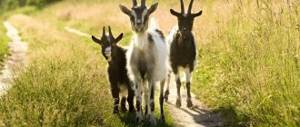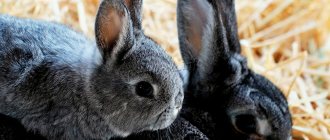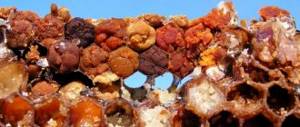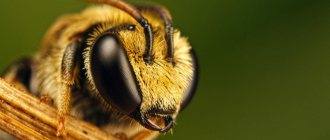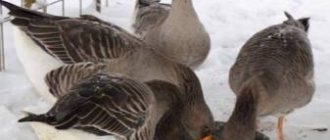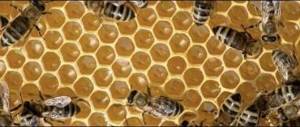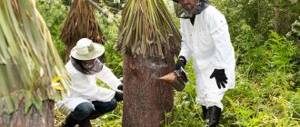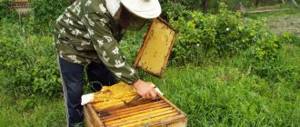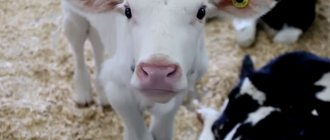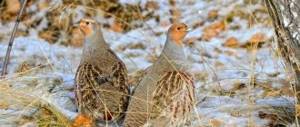How does a bee colony work?
Some owners identify the inhabitants of the hive with other pets - goats, chickens, piglets - which is not entirely true. Bees, like ants, belong to the so-called “social” insects: a bee individual cannot survive alone, and a community of different individuals exists as a living system, a single superorganism.
Its basis is the nest, the uterus, worker bees, drones, and brood. Each element of the system performs certain functions and at the right moment, after all vital resources have been exhausted, is replaced with a new one.
And here the question arises: why do insects that hatched from the same eggs and had the same parents have different life spans - from 6 weeks to 6 years? Let's take a closer look at what affects the lifespan of three key figures - the queen bee, the worker bee and the drone.
You will find answers to questions about how relationships are built in a bee family and which bees make honey in the article on our website.
Hierarchy of the bee colony
Presented in the singular and serves as a producer of offspring. It is the largest in size and reaches 3 cm in length. Her task is to lay up to two thousand eggs every day. She is not burdened with any other responsibilities. She is fed, looked after, warmed and cleaned. She feeds on royal jelly.
Its lifespan is much longer than other bees and can reach 4-5 years!
The more eggs this privileged female lays, the shorter she lives. But at the same time, if she produces fewer offspring than the hive requires, then she can be expelled and replaced with another, more fertile one. And without care, she dies of hunger.
Male bees whose main function is to fertilize the queen. They are smaller in size and their length is 1.5-1.7 cm, and their number reaches several thousand.
Their lifespan can vary greatly from 2-3 weeks to a year. Since the family needs them only in the summer, they appear in late spring and, as a rule, live only in the summer. Some of them may die after the first fertilization, some in the process of fighting with other drones for the right to inseminate the queen.
The drone may be lucky, but this is only in the case when the old queen does not fulfill her duties and is not able to replenish the size of the family, and the young one is not yet there. Then the drones are left so that with the appearance of a new queen they can continue to replenish the required number of bees.
They are completely dependent on worker bees and without their care they quickly die from cold and hunger.
Sometimes the expelled may be accepted into another family if the womb is not fertilized, but, as a rule, they are expelled after fulfilling this duty.
The main part of the family. It consists only of females. They cannot perform sexual function due to the fact that their reproductive organs are underdeveloped. They are the smallest in size, their length is 1-1.5 cm, and the number reaches up to 80,000 in the summer, and up to 30,000 females in the autumn-spring period.
They are real hard workers. Extraction of nectar, pollen and their delivery to the hive, construction of honeycombs, care and supply of food for the queen, larvae and drones, cleaning - this is their responsibility.
Their lifespan may be influenced by the time of birth. If it is summer, then they will work much more intensively during the honey harvest period, and, accordingly, will live about 20-25 days. If it is autumn, then the load will be much less, and life can reach six months. They may well overwinter and continue to raise new offspring in the spring.
Life cycle of a honey bee
After the queen has laid an egg, 3 weeks pass until hatching. On the fourth day, the larva destroys the egg shell, and the process of feeding it begins, which is carried out by young insects that have not yet flown out of the hive. The larva is fed milk for three days, and on the fourth it is given a mixture of pollen, water and honey. After 7 days, the larva grows so that it no longer fits into the cell of the honeycomb, and it is sealed in wax, which is where the second stage of its development begins.
This stage lasts about twelve days, and then, destroying the waxy shell, a young bee is born.
The third stage is coming. The bee does not work for the first two days after hatching. On the third day she starts work. First, this will be cleaning your own, and then other cells for new clutches of eggs. For four days, the young bee is fed by other individuals, and on the fourth day she already feeds on her own, after her glands that produce royal jelly begin to work. And after a week, the formed individual can already feed other young bees.
At the same moment, the wax-secreting glands begin their work, and the young insect takes part in the construction of the hive. After 2 weeks, the amount of wax produced decreases, and the bee begins to clean the hive.
On day 22, the young bee turns into an adult, which begins its “flight career”. Now her responsibility includes collecting nectar and producing honey. In one entrance, a bee can bring up to 40 mg of nectar and 15 mg of pollen. And this continues for about 30 days, until the insect’s strength leaves and it dies. The bee works hard, and work, as they say, makes horses die.
Honey bees live according to the laws established in the bee family and strictly adhere to the established rules. Hence the high level of organization.
How long does a bee live depending on the species?
The lifespan of bees does not depend on their species. It has been scientifically proven that the main factor is the time of birth of individuals. Bees that were born at different times of the year even differ from each other in anatomy. Autumn insects are larger, since they do not have to spend their fat reserves on intensive work.
Bees are extremely useful insects, but, unfortunately, they do not have a high life expectancy. Even under favorable conditions, the absence of diseases, natural enemies and proper care, the lifespan of an ordinary worker bee is no more than 25 days. Moreover, in just one season, insects manage to produce a sufficient amount of honey both for collecting and for feeding the offspring.
The role of bees in pollination and nectar collection of different plant species
In this article we will look not only at information about the lifespan of bees, drones and queens, but also provide factors that can extend the lifespan of this extremely useful insect.
Honeybearing individuals live the shortest in bee colonies; the period is no more than 35 days. In weak families the duration does not reach 20 days. This is due to intense work. Winter individuals can live up to six months.
What is the lifespan of a drone?
A drone is a male whose sole task is to fertilize the queen bee. “Male” bees do not take part in the “household” affairs of the hive and the production of honey.
They are born only at the end of the spring season (the period of fertilization), since at other times the family does not need them. The average life cycle is no more than 2 months, but most often it is much shorter, which is due to the physiology and internal orders of the family.
Drones are ready for fertilization approximately 10–14 days after birth. They die immediately after they have exhausted all sperm (male reproductive cells). Many individuals die much earlier. They have to fight for the right to fertilize the uterus, and many die during such fights.
If a drone survives the fight for the queen, but does not fertilize her, he is subject to expulsion from the family. As you know, they cannot survive alone, since they are not able to get food for themselves without outside help. During times of hunger in the hive, they devour the reserve reserves of worker honey bees.
How long does a bee live after being stung?
Often, the appearance of a bee causes fear in people, and they try to drive it away by waving their arms, handy objects, not realizing that they are only doing worse - they show the bees that they are aggressive, and they themselves attract attention, bees do not attack just like that, they peaceful insects, minding their own business.
The lifespan of a stung bee is very short, does not exceed 2-3 hours. There is information that the bees remained alive and worked as usual after the sting, but this fact has not been confirmed.
Why does a bee die after being stung? Everything is quite simple. Having pierced the sting into the elastic skin of a person and sprayed out the poison, the insect will actively try to get it back. But he won't succeed.
The sting is firmly stuck in the victim's body, and can only be pulled out with tweezers or other means. Along with the sting, poisonous glands and part of the intestine remain in the person, since the wound is quite extensive, the bee has practically no chance of survival.
Interesting fact. Bees will never bite if their abdomen is sufficiently filled with honey. In addition, the queen will not sting, even if you mock her - she uses her sting only when meeting with a rival.
All life spans of these insects are quite arbitrary. To ensure the long life of your apiary, first of all, you need to properly care for the bees and create all the necessary conditions.
How long do bees live in a hive?
Insects live for only a few days, so it is very respectable to organize the hive correctly, timely separate individuals and vigilantly monitor the condition of the bee house.
When asked how many years domestic bees live, it is advisable to give the following explanation. First of all, a huge share of energy costs goes to the continuous cultivation of new individuals in the summer-spring period. The more energy a bee expends, the less time it will live.
Note. The daily litter of individuals during the period of family formation can reach up to 2000 units.
How long does a bee live?
To an uninitiated person it may seem that an ordinary bee lives, if not a year, then at least several months. But, unfortunately, this is not the case.
Even if the bee does not encounter a natural enemy or is accidentally crushed by a person, its life expectancy will be no more than 35 days. In just a month of life, this insect manages to do a lot of useful things: collect nectar, build honeycombs or protect the offspring from enemies, depending on the distribution of responsibilities in the hive
To know exactly how long a bee can live, you need to take into account its work responsibilities in the hive, as well as a number of other factors that influence life expectancy.
In the following sections we will consider not only the structure of the bee colony, but also the main indicators that can extend or shorten the lifespan of insects.
Uterus
Like ants, bees have a matriarchy. The main one in the family is the uterus - a female individual with developed genital organs. It is different from others and has a large size, a slender and elongated body, and the tips of its wings protrude beyond the abdomen. Her responsibilities include, first of all, laying eggs, thereby controlling the size of the colony.
The whole life of the family revolves around her - all possible conditions of “bee comfort” are available only to her. This allows the queen to have the longest lifespan.
So, how long does a queen bee live? According to experts, the average lifespan of a uterus is from 3 to 5 years . But, often, beekeepers prefer to change the female every 1–2 years.
If the beekeeper does not do this, then, if the queen’s fertility decreases, the bees themselves will do it. This process is called “quiet replacement” - the old individual remains in the hive until the new one appears. After the new queen begins to lay eggs, the old one is expelled or destroyed.
This high life expectancy can be explained by the characteristics of this individual:
- The uterus leads a calm and measured lifestyle with minimal physical activity. The fact is that she does not need to waste energy searching for pollen or collecting nectar, since worker bees are responsible for her nutrition.
- This individual receives increased nutrition, especially during the period of larval laying. The basis of the uterus' diet is milk, which contains a lot of protein and microelements. Thanks to this, recovery processes occur much faster in the individual’s body.
- Since the queen is the largest individual in the family, and her vitality directly affects the health and well-being of the family, worker bees not only provide her with adequate nutrition, but also protect her from external enemies. In such conditions, the queen of the hive can live up to five years.
Worker bee
The bee family mainly consists of worker bees. In a large family in winter there can be from 20 to 30 thousand of them, and in summer their number can reach 80 thousand. All working individuals are females with undeveloped genitals. Working individuals perform all the main work inside the hive. Their responsibilities include:
- nest cleaning;
- construction of new cells;
- uterine care;
- feeding larvae;
- maintaining cleanliness and temperature in the hive;
- collection and replenishment of supplies.
Characteristics of the Karnika bee breed
If necessary, these workers can also perform security functions. This amount of work has a negative impact on life expectancy. How long does a worker bee live? The average life expectancy, according to experts, is 30 days. In exceptional cases, insects can live for several months.
Lifespan of a worker bee
Worker bees are female creatures; due to their physiological characteristics, they lack the ability to reproduce. It is from them that the majority of the bee colony consists. They perform many functions:
- collect nectar and pollen from flowers;
- deliver water for the entire bee family;
- build honeycombs;
- clean the hive;
- create the necessary microclimate;
- protect their home;
- serve queens, drones, and larvae.
How long a worker bee lives is influenced by many factors:
- climatic conditions of the habitat;
- time period of the brood (season of the year);
- intensity, amount of work performed;
- nutrition;
- wintering conditions.
The lifespan of a worker bee largely depends on the time of birth. An individual born in the spring can live up to 35-40 days. A summer bee (June bee) may live up to 30 days. Autumn ones live longer - up to six months or a year.
Drone lifespan
Drones are hatched from a special brood in each hive, and they are born in late spring. During this time, worker bees have time to get stronger and prepare the hive for the new season.
Drones are ready to mate within two weeks of birth. Interestingly, the factors that influence the lifespan of a worker do not apply to drones at all. Males are constantly in the hive and do not obtain food on their own.
Their lifespan directly depends on the time of mating with the queen. As soon as the male ejects the seed, death will occur. In addition, a certain percentage of drones die during the struggle to mate with the queen.
All remaining drones are completely dependent on female workers. Since they are the ones who feed them, in the autumn the family is completely freed from males.
The fact is that with the arrival of cold weather, the uterus stops laying eggs and the need for fertilization disappears. Therefore, worker bees simply drive the drones out of the hive, and they simply die from lack of food and cold.
However, there are exceptions to this rule. For example, if during the summer season the queen died or the family lived without this individual, several drones may be left for the winter. They will be responsible for the first brood in the spring, when a new queen appears in the hive
Composition and responsibilities of hive members
A bee family includes one queen, several hundred or tens of thousands of workers, and tens or hundreds of drones. When the hive is in the growing stage, multiple queens are allowed.
It is important to understand that this fact is not accidental, since the hive is a kind of community. Its representatives replace each other at certain time intervals, but the integrity of the family is not lost, since their lifestyle involves working and living together, and individual existence is impossible.
The lifestyle of a worker bee is as follows:
- Construction of warehouses for feed (honeycombs).
- Collection and storage of supplies.
- Feeding the offspring.
- Hive protection.
- Filling all the needs of the bee family.
Queen bee and her life cycle
The uterus is engaged in laying eggs, the number of which is 2000 or more units, which in weight is significantly greater than its own body weight.
The drone has only one duty - fertilization of the uterus. But sometimes he can act as a bodyguard. Thus, when birds encroach, the latter prefer not to touch the queen, but to feast on a nearby bee.
During the process of insemination, the share of the reproductive organ is split off and the drone dies . They are designed in such a way that they cannot carry out other bee activities, due to the fact that they lack wax glands, pollen collection containers and a sting. In addition, the drone has a significantly short proboscis, which is not in its favor.
Varroatosis of bees: prevention and treatment of varroatosis
In breeding conditions, the bee colony is engaged in preparatory work, including: laying queens and drones for subsequent reproduction, scouting for a new habitat for the hive.
Young honey bees operate in energy saving mode, due to the fact that most of their energy will be needed when collecting pollen.
When the preparatory measures are completed, the hive sends 1, often several swarms (queen with workers) for the purpose of autonomous life in another place. This happens during the natural course of the reproduction pattern and functioning of hives. But experienced beekeepers do not allow such developments, distributing families in advance at their discretion, which guarantees order.
Responsibilities of growing bees
After about 1.5 weeks of work in the bee house, the grown honey-bearing individuals move on to field duties. In conditions of a colossal loss of old workers, with a large volume of work, the time spent in the hive is reduced. But it may also happen that a certain number of worker bees will take on “household” duties.
Bee workers acquire skills gradually:
- Water transfer.
- Pollen collection.
- Nectar collection.
The older, more professional representatives begin exploration to find new sources of nectar. These bees have an external characteristic feature - a bald back.
The most favorable flight distance to honey plants is considered to be Ø 3 km. Of course, workers make flights of 5-7 km. At the same time, they lose their vital resources and die faster.
How long does a bee live in nature?
There is a big difference in lifespan between bees kept in a hive and those living in the wild. Statistics show that wild insects live 25% longer. This is influenced by the following factors:
- There is no impact from humans who take away food.
- Insects work less, so their body is not depleted.
- There is no need to produce large brood.
- Wild bees have stronger immunity.
The wild queen lives for about five years. In some cases, the age can reach eight. During their most active period, worker bees live up to 50 days.
The exception to this question would be the lifespan of drones. It is the same both in the wild and in the hive. These individuals are needed only for reproduction, therefore, after fulfilling their direct duties, they can be expelled from the family.
Comparison and conclusions in the table
As can be seen from all of the above, the average life expectancy of each type of insect depends on the function it performs, as well as on external conditions. In principle, the average lifespan of a worker bee is about 30 days, a queen bee about 3 years, and a drone until fertilization.
For convenience, the data is summarized in a table.
| Type of individual | Favorable conditions | Unfavourable conditions |
| Working | 40 days | 20 days |
| Uterus | 5 years | 2 years |
| Drone | 10 days | 2-3 months |
Factors influencing life expectancy
The bee family is very numerous. It can reach up to 10,000 individuals. During the year, the number of family members constantly changes due to different life spans. Only the uterus remains unchanged, it is always alone. The following factors influence life expectancy:
- Time of birth of insects . Brood in families occurs several times a year. The energy necessary for life is spent on feeding. Insects tolerate summer brood most easily. They adapt well to heat. In autumn, on the contrary, they have to expend a lot of strength and energy, since dampness and low temperatures are detrimental to their health. Winter is the most difficult, as insects need a lot of energy to stay warm. Not all individuals always tolerate frost.
- How long the queen bee lives is affected by the laying of eggs . The more there are, the faster she ages.
- The body of insects is depleted due to a lack of vitamins or from past diseases .
Interesting Facts
In Australia, scientists have begun experiments in cloning several varieties of grapes grown in cold regions. Climate warming, which is predicted for the next 50 years, will lead to their disappearance. Australian varieties have excellent characteristics for winemaking and are not susceptible to diseases common in Europe and America.
Convenient Android applications have been developed to help gardeners and gardeners. First of all, these are sowing (lunar, flower, etc.) calendars, thematic magazines, and collections of useful tips. With their help, you can choose a day favorable for planting each type of plant, determine the timing of their ripening and harvest on time.
You need to collect medicinal flowers and inflorescences at the very beginning of the flowering period, when the content of nutrients in them is highest. Flowers are supposed to be picked by hand, tearing off the rough stalks. Dry the collected flowers and herbs, scattered in a thin layer, in a cool room at natural temperature without access to direct sunlight.
Bee family reproduction process
Oklahoma farmer Carl Burns developed an unusual variety of multi-colored corn called Rainbow Corn. The grains on each cob are of different colors and shades: brown, pink, purple, blue, green, etc. This result was achieved through many years of selecting the most colored ordinary varieties and crossing them.
In little Denmark, any piece of land is a very expensive pleasure. Therefore, local gardeners have adapted to growing fresh vegetables in buckets, large bags, and foam boxes filled with a special earthen mixture. Such agrotechnical methods make it possible to obtain a harvest even at home.
In a hive or a forest - is there a difference in lifespan?
How long do bees live in nature and is there a difference in the life expectancy of domestic and wild insects? Yes, there is a difference. Wild insects have a different life expectancy. According to statistics, the average lifespan of wildlife is 20–30% longer. This is due to the following factors:
- wild bees are not influenced by humans - the beekeeper will not come to them and take away the collected supplies;
- they work less – insects’ bodies deplete more slowly;
- insects do not have to produce large brood;
- wild bees have stronger immunity.
average lifespan of a wild queen 8 years . Working individuals , even during the most active period of nectar collection, live on average 45 days .
The exception is the life of drones. In the wild, they live as long as bees live in a hive. Drones are needed only for reproduction and, after performing their main function, they die or are expelled by the colony as unnecessary.
An interesting fact is that if they lose their queen, bees can extend their lifespan up to 200 days. In this way, nature gives the family the opportunity to raise a new female and prevent the colony from dying out.
How long do bees live in nature?
The lifespan of a bee in nature depends on certain conditions:
- time of year (in winter, individuals live much longer);
- social category (the queen lives the longest, the working bees the least);
- the strength of the bee colony (weak individuals die faster);
- the amount of nectar collected, honey produced (the more intense the work, the shorter the life).
In addition, there are certain nuances that significantly extend the lifespan of honey creators:
- Lack of a fertile uterus. Drones have the opportunity to “rest” for a long time in the bee house, being fully supported by worker bees, in the interests of preserving the fertilization capabilities of the emerging queen. In addition, worker bees are also able to live much longer than usual, since their functionality is significantly retained (they do not waste energy on caring for their offspring).
- Long-lived queens, living for more than 5 years. If in a hive it is recommended to change the queen every 1-2 years, then in nature this is not observed.
Keep in mind! That the older the queen is, the worse the reproduction process becomes, and more and more drones are born in the offspring.
The queen lives the longest in the wild; she can live up to 7 years. The life span of worker bees and drones in nature actually does not differ from the life span of “domesticated” insects.
How long does a queen bee live?
The queen bee, unlike worker insects, lives quite a long time. Its average lifespan ranges from 4 to 5 years. What makes her life so long?
- The uterus leads a measured, calm lifestyle, with about twenty servants (retinue) constantly with her. They feed her, clean her, and treat her if necessary. The queen bee feeds not on ordinary nectar, but on royal jelly secreted by her retinue especially for her. Royal jelly is the most nutritious and micronutrient-rich product produced by bees.
It may seem that
the queen controls the entire hive .
This is far from true. The workers themselves have a greater influence on the life expectancy of the queen bee. If the family decides that their queen cannot cope with her duties, they kill her without regret and take out another “mistress”. The queen is most productive in the first two years of her life, so many beekeepers prefer to change them every two years. Under laboratory conditions, a queen bee can live up to 8 years, but in practice their lifespan rarely exceeds 3 years. We also recommend reading:
The Cebro method in beekeeping: breeding queens and more Making hive frames with your own hands Bee diseases, their signs and methods of treatment Catching wild bee swarms using traps and empty hives
